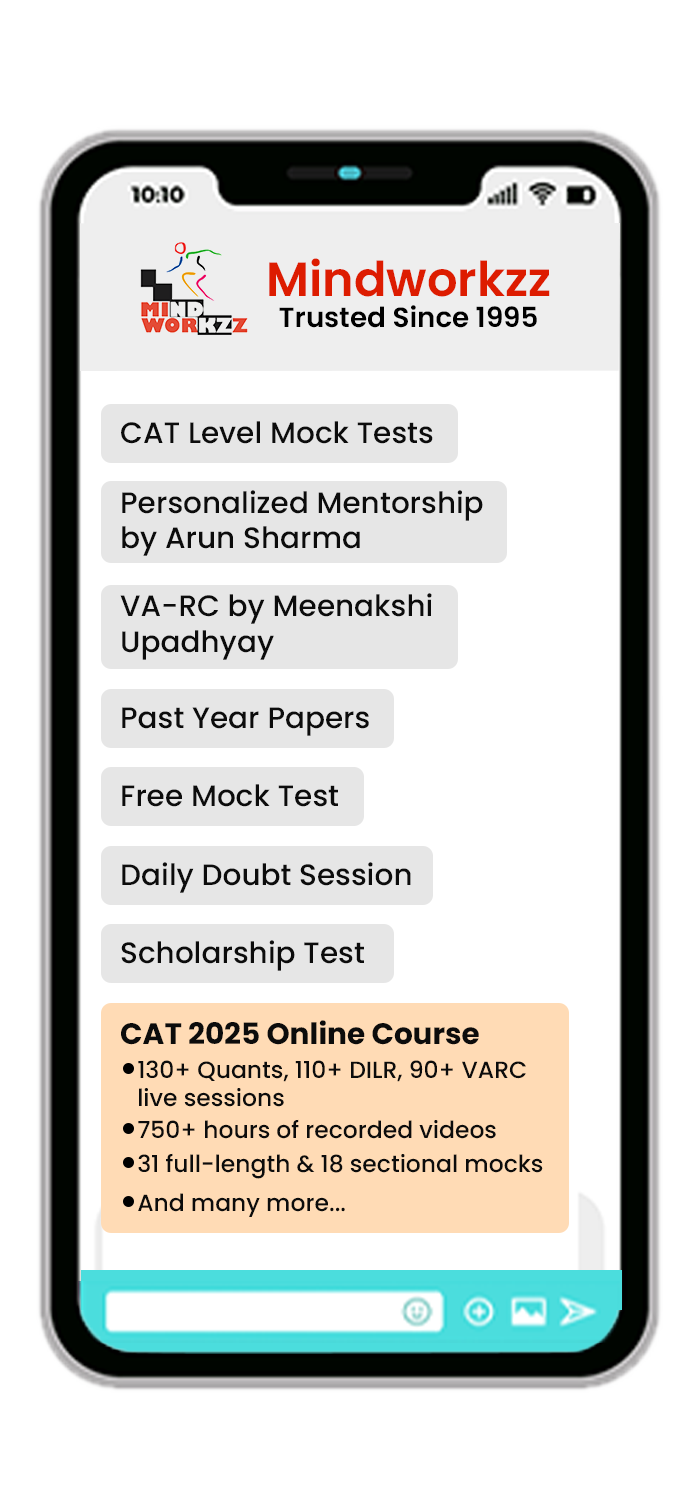How to prepare for CAT 2026? This is one of the most common and critical question that arises in the minds of thousands of candidate’s before beginning their CAT preparation journey. While obviously there can be several approaches to this, CAT 2026 preparation revolves around striking the right balance between consistent practice and understanding concepts.
Let’s understand more about How to Prepare for CAT 2026 and get the opportunity to secure seat in your dream-B school.

How To Prepare For CAT 2026
To excel in CAT 2026, it is highly important to focus and prioritise the high-weightage topic and have a well-structured preparation roadmap. Prioritising the high weightage topics help you to attend more questions and score marks which will boost up the chances of cracking the exam and increases the probability of getting a seat in your dream B-school.
How to prepare for CAT 2026: Preparation Tips
Here are some key preparation tips to performs best in CAT 2026:
Understand the CAT exam Syllabus and Exam Pattern
- CAT is a two-hour exam with 40 minutes allotted to each section.
- CAT exam comprises of 3 sections- VARC (Verbal Ability and Reading Comprehension), Data Interpretation and Logical Reasoning (DILR), Quantitative Ability (QA)
- Most importantly, Know about the weightage and topics within all the three sections
Build a Strong Foundation and conceptual understanding
- Make your foundation strong in and clear basics of Quants (Algebra, Arithmetic and Geometry)
- Read reliable essays from authenticated resources, novels, newspapers, and editorials daily for strengthening VARC
- Practice sets and puzzles regularly for DILR
Make a well study plan
- Allocate daily time with consistency for all the three sections
- Make daily, weekly, and monthly targets more efficient and productive study hours
- Leave buffer time for mocks and revision
Take mock tests regularly
- Start with 1 mock/month and gradually increase to 1-2 mocks per week.
- Most important, analyse your mocks after each test
- Focus on accuracy and time management
Section-wise consistent practice
- Do not neglect any of the section or done be overconfident about any particular section.
- VARC: Read daily + practice RCs daily, odd-one out and para jumbles
- DILR: Solve different type of DI and LR sets. Start from easier ones and gradually with practice and time increase the difficulty level.
- QA: Daily practice + clear basics + learn shortcut, tricks, and techniques + topic-wise revision
Focus on weaker sections
- Identify the topics where you consistently struggle frequently and make mistakes
- Devote extra time to practice those areas
- Do not avoid practicing hard topics
Work on accuracy and speed (accuracy > speed)
- Time your practice sessions
- Avoid any guesswork’s to reduce negative marking
- Practice shortcut methods for Quants
- Speed and accuracy both are essential components to score good but keep in mind accuracy is much more important as even a minor mistake may lead to wrong answer.
Join a coaching (optional)
- Helps in timely preparation, maintains consistency and discipline throughout the preparation journey and effective peer competition
- Choose based on your learning style and availability of time (online/offline/ self-study)
Revise and stay consistent
- Revise concepts, tricky questions, formulas, techniques regularly
- Stay disciplined and consistent throughout your preparation journey
How to prepare for CAT 2026: For Beginners
If you are targeting for CAT 2026 journey as a beginner, build a strong foundation and streamline your preparation.
- The first step is to gain a crystal-clear understanding of the exam pattern and structure and focus on building strong foundational skills.
- Attempt a full-length mock test before starting up the preparation journey to test and evaluate your current stand and highlight weak areas.
- Revisit the basic mathematical concepts and develop reading habits. With reading, make sure to develop the ability to comprehend the what you are actually reading (editorials, articles, magazines, aeon essays etc) well.
- Ones you are done with the basics, you can now gradually transition to practicing topic-specific questions and sectional tests to build depth.
- Preparing for CAT 2026 as a beginner and first-time aspirant can feel overwhelming due to its vast extensive syllabus and complexity of questions.
- Being a beginner and a first timer exam taker, to make your preparation journey more effective you can enrol in an online/offline coaching program as these can be highly beneficial.
- The coaching platforms will give a structured approach to learning, expert mentorship and access to quality comprehensive study materials and mock exams- helping you to stay on track and improve your performance consistently.
How to prepare for CAT 2026: For Working Professionals
If you are targeting for CAT 2026 journey as a working professional, build consistency and streamline your preparation.
- Working professional aiming to crack CAT 2026, must adopt a well-planned, disciplined, and structured approach to balance rigorous work life commitments and study hours.
- Your success depends on strategic resource selection, smart time management, and maintaining consistency despite a hectic schedule.
- With limited hours available on weekdays, professionals should dedicate 3-4 consistent focused hours for studying and reserve 7-8 hours over the weekend for deeper revision, and mock practice.
- Since you have limited time, and time is at a premium, it is highly essential to rely on premium and reliable quality study materials rather than depending on multiple resources.
- This is why working professionals opt for online coaching materials for comprehensive and structured materials, updated content, reordered and live video sessions allowing professionals study according to their convenience.
How to prepare for CAT 2026: Section-Wise
Verbal Ability and Reading Comprehension
- Mastering VARC section requires consistency, well-structured approach as well as proficiency in language building.
- Since the VARC sections is highly comprehensive driven, candidates need to focus on reading and topic specific preparation strategies.
Reading Comprehension (RC)
- Read a variety of articles and texts daily, editorials, articles from sites like aeon essays, magazines, features from reputed journals and newspapers to develop familiarity with variety of reading styles.
- After reading, develop habit of writing 1–2-line summary to understand the main idea of the paragraph and improve retention.
- Solve RC passages from past CAT papers and mocks ton understand common question type, tone, main idea, inference.
- Focus on comprehension and reading speed under pressure and time conditions. Aim to complete one RC set in 10 minutes during the practice period.
Para Jumbles
- First begin solving by finding starting or introductory sentence that sets the tone and topic of the paragraph.
- Identify interlinking or connecting words like therefore, however, also, as these state relationship between sentences which helps in identifying the order.
- Focus on how sentences are connected logically to each other and make up a meaningful paragraph.
Odd Sentences Out
- Read out all the given sentences and identify the theme or the central idea that binds most pf the sentences together and form a meaningful paragraph.
- Identify the sentence that deviates in logical flow, subject, tone and stands out among rest of the all.
- Practice consistently to improve your ability to detect sentences that break the flow with unwanted and unrelated concepts.
Para Summary
- Go through the passage with full attention and identify the core message.
- Identify the main idea and determine the argument, other supporting points.
Data Interpretation and Logical Reasoning
The DILR section of the CAT exam evaluates ones logical decision-making skills, analytical thinking, and ability to read and interpret complex data. To perform exceptionally well, aspirants must focus on developing conceptual understanding combined with speed and accuracy.
Data Interpretation (DI)
- Practice and master the skill of interpreting data from line charts, bar graphs, pie charts, caselets, and tables. These appear in CAT as well as OMETS (Other Management Entrance Exams).
- Sharpen mental calculations and approximation methods to save time. Master the trick to eliminate unlikely options logically and using estimation methods when the calculations are very time-consuming.
- Master the ability to identify and analyse the sets critically and logically. Try to look beyond the surface to find out hidden patters, anomalies, and trends.
- Practice DI sets under timed conditions to learn to solve under pressure with both speed and accuracy.
Logical Reasoning (LR)
- Begin practicing with common recurring formats found in CAT and frequently asked question types like ranking, team/group selection, seating arrangements etc.
- Master reasoning ability by solving wide variety of puzzles of varying level of difficulty. This helps you to find questions of different levels ad formats which helps you to improve practice.
- Focus on improving ability to analyse and identify relationships and patterns quickly, which is the key element of solving LR sets.
Quantitative Aptitude
The QA section of the CAT exam is designed to tests one’s basic mathematical understanding, analytical thinking, and numerical reasoning.
- Strengthening of the basics and understanding of core concepts of Arithmetic, Algebra, Geometry, Modern Mathematic and Number Systems is highly essential.
- Questions of CAT exam is of varying difficulty level and from multiple areas therefore having a good conceptual understanding is highly important to solve the questions.
- Prioritize high-weightage topics like arithmetic, algebra, geometry, etc. Start covering these topics first to gain maximum attempts and secure easy to moderate marks initially. Then gradually moves to topic like mensuration, number system and others.
- Maintain a handbook containing essential short cut techniques, important formulas, for time-to-time revision. Revise this book every alternative day to keep the concepts fresh in mind.
How To prepare for CAT 2026: Conclusion
To score well in CAT 2026, candidates must follow a well-structured approach and must set up their foundation for all the three sections before stepping into the extensive level of preparation. It is highly necessary to stay consistent, practice regularly, be dedicated and disciplined throughout the learning journey.
FAQs How To prepare for CAT 2026
To prepare for CAT 2026 as a beginner, first understand the CAT exam pattern and syllabus, build foundation and conceptual clarity, reading habit and comprehension ability.
To prepare for CAT 2026 working professional must spend quality time studying during weekends by dedicating around 7-8 hours and 2-3 hours on weekdays by relying on quality resources.
The ideal time to start CAT 2026 preparation is at least 10–12-month prior before the exam to ensure syllabus completion, enough revision and good amount of mock practice.
Candidates must attempt at least 2 mocks per week during the initial phase of preparation and then gradually 3-4 mocks per week.




